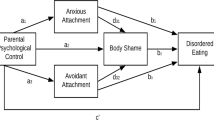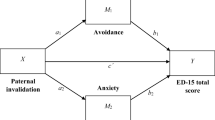Abstract
Purpose
Childhood trauma and parental bonding have been widely recognized as risk factors for eating disorders (EDs). However, their interplay in determining ED psychopathology has been poorly investigated. Consequently, we have assessed their interaction with core ED psychopathological symptoms.
Methods
Fifty-seven patients with anorexia nervosa, 43 with bulimia nervosa and 77 healthy women completed the Childhood Trauma Questionnaire, the Parental Bonding Instrument and the Eating Disorder Inventory-2. Chi square test and regression analyses with a moderation model were performed to investigate the interplay between childhood trauma, parental bonding and ED symptoms such as ineffectiveness, social insecurity, drive to thinness, interoceptive awareness, impulsivity and perfectionism.
Results
Compared to controls, patients with EDs showed higher levels of trauma and parental control perception and lower levels of parental care. Childhood maltreatment was more prevalent in patients with the affectionless control parental style. Moderation analyses revealed that higher maternal control significantly predicted the ED symptom of social insecurity only when participants experienced lower levels of emotional abuse.
Conclusions
These findings demonstrate an interplay between deranged problematic parental bonding and childhood trauma in promoting a possible vulnerability to social insecurity, one of the most central dimensions of ED psychopathology. This interaction might have psychotherapeutic implications.
Level of evidence
Level V, cross-sectional descriptive study.

Similar content being viewed by others
References
Hay P, Chinn D, Forbes D, Madden S, Newton R, Sugenor L, Touyz S, Ward W (2014) Royal Australian and New Zealand College of Psychiatrists clinical practice guidelines for the treatment of eating disorders. Aust N Z J Psychiatry 48:977–1008. https://doi.org/10.1177/0004867414555814
Jacobi C, Hayward C, de Zwaan M, Kraemer HC, Agras WS (2004) Coming to terms with risk factors for eating disorders: application of risk terminology and suggestions for a general taxonomy. Psychol Bull 130:19–65. https://doi.org/10.1037/0033-2909.130
Molendijk ML, Hoek HW, Brewerton TD, Elzinga BM (2017) Childhood maltreatment and eating disorder pathology: a systematic review and dose-response meta-analysis. Psychol Med 47:1402–1416. https://doi.org/10.1017/S0033291716003561
Tasca GA, Balfour L (2014) Attachment and eating disorders: a review of current research. Int J Eat Disord 47:710–717. https://doi.org/10.1002/eat.22302
Bowlby J (1982) Attachment and loss, attachment. vol 1, 2nd edn. Basic Books, New York
Hazan C, Shaver PR (1987) Romantic love conceptualized as an attachment process. J Pers Soc Psychol 52:511–524
Mikulincer M, Shaver PR (2007) Attachment in adulthood: structure, dynamics, and change. Guilford Press, New York
Waters E, Merrick S, Treboux D, Crowell J, Albersheim L (2000) Attachment security in infancy and early adulthood: a twenty-year longitudinal study. Child Dev 71:684–689. https://doi.org/10.1111/1467-8624.00176
Baldwin MW, Keelan JPR, Fehr B, Enns V, Koh-Rangarajoo E (1996) Social-cognitive conceptualization of attachment working models: availability and accessibility effects. J Pers Soc Psychol 71:94–109
Mikulincer M, Shaver PR (2007) Boosting attachment security to promote mental health, prosocial values, and inter-group tolerance. Psychol Inq 18:139–156. https://doi.org/10.1080/10478400701512646
Levy KN, Blatt SJ, Shaver PR (1998) Attachment styles and parental representations. J Pers Soc Psychol 74:407–419. https://doi.org/10.1037/0022-3514.74.2.407
Perris C, Andersson P (2000) Experiences of parental rearing and patterns of attachment in adulthood. Clin Psychol Psychother 7:279–288. https://doi.org/10.1002/1099-0879(200010)7:4%3C279::AID-CPP260%3E3.0.CO;2-7
Liu Q, Shono M, Kitamura T (2008) The effects of perceived parenting and family functioning on adult attachment: a sample of Japanese university students. Open Fam Stud J 1:1–6
Wilhelm K, Gillis I, Parker G (2016) Parental bonding and adult attachment style: the relationship between four category models. Int J Women’s Health Wellness 2:16
Parker G, Tupling H, Brown LB (1979) A parental bonding instrument. Br J Med Psychol 52:1–10. https://doi.org/10.1111/j.2044-8341.1979.tb02487.x
Mikulincer M, Shaver PR (2012) An attachment perspective on psychopathology. World Psychiatry 11:11–15. https://doi.org/10.1016/j.wpsyc.2012.01.003
Sroufe LA, Carlson EA, Levy AK, Egeland B (1999) Implications of attachment theory for developmental psychopathology. Dev Psychopathol 11:1–13
Dakanalis A, Timko CA, Zanetti MA, Rinaldi L, Prunas A, Carrà G, Riva G, Clerici M (2014) Attachment insecurities, maladaptive perfectionism, and eating disorder symptoms: a latent mediated and moderated structural equation modeling analysis across diagnostic groups. Psychiatry Res 215:176–184. https://doi.org/10.1016/j.psychres.2013.10.039
Tasca GA, Kowal J, Balfour L, Ritchie K, Virley B, Bissada H (2006) An attachment insecurity model of negative affect among women seeking treatment for an eating disorder. Eat Behav 7:252–257. https://doi.org/10.1016/J.EATBEH.2005.09.004
Monteleone AM, Castellini G, Ricca V, Volpe U, De Riso F, Nigro M, Zamponi F, Mancini M, Stanghellini G, Monteleone P, Treasure J, Maj M (2017) Embodiment mediates the relationship between avoidant attachment and eating disorder psychopathology. Eur Eat Disord Rev 25:461–468. https://doi.org/10.1002/erv.2536
Monteleone AM, Cardi V, Volpe U, Fico G, Ruzzi V, Pellegrino F, Castellini G, Monteleone P, Maj M (2018) Attachment and motivational systems: relevance of sensitivity to punishment for eating disorder psychopathology. Psychiatry Res 260:353–359. https://doi.org/10.1016/j.psychres.2017.12.002
Gander M, Sevecke K, Buchheim A (2015) Eating disorders in adolescence: attachment issues from a developmental perspective. Front Psychol 6:1136. https://doi.org/10.3389/fpsyg.2015.01136
Tetley A, Moghaddam NG, Dawson DL, Rennoldson M (2014) Parental bonding and eating disorders: a systematic review. Eat Behav 15:49–59. https://doi.org/10.1016/J.EATBEH.2013.10.008
Romans SE, Gendall KA, Martin JL, Mullen PE (2001) Child sexual abuse and later disordered eating: a New Zealand epidemiological study. Int J Eat Disord 29:380–392. https://doi.org/10.1002/eat1034
Yamaguchi N, Kobayashi J, Tachikawa H, Sato S, Hori M, Suzuki T, Shiraishi H (2000) Parental representation in eating disorder patients with suicide. J Psychosom Res 49:131–136 (PMID: 11068057)
Guillaume S, Jaussent I, Maimoun L, Ryst A, Seneque M, Villain L, Hamroun D, Lefebvre P, Renard E, Courtet P (2016) Associations between adverse childhood experiences and clinical characteristics of eating disorders. Sci Rep 6:35761. https://doi.org/10.1038/srep35761
Caslini M, Bartoli F, Crocamo C, Dakanalis A, Clerici M, Carrà G (2016) Disentangling the association between child abuse and eating disorders. Psychosom Med 78:79–90. https://doi.org/10.1097/PSY.0000000000000233
Monteleone AM, Monteleone P, Serino I, Scognamiglio P, Di Genio M, Maj M (2015) Childhood trauma and cortisol awakening response in symptomatic patients with anorexia nervosa and bulimia nervosa. Int J Eat Disord 48:615–621. https://doi.org/10.1002/eat.22375
Monteleone AM, Monteleone P, Volpe U, De Riso F, Fico G, Giugliano R, Nigro M, Maj M (2018) Impaired cortisol awakening response in eating disorder women with childhood trauma exposure: evidence for a dose-dependent effect of the traumatic load. Psychol Med 48:952–960. https://doi.org/10.1017/S0033291717002409
Monteleone AM, Patriciello G, Ruzzi V, Cimino M, Del Giorno C, Steardo L Jr, Monteleone P, Maj M (2018) Deranged emotional and cortisol responses to a psychosocial stressor in anorexia nervosa women with childhood trauma exposure: evidence for a “maltreated ecophenotype”? J Psychiatr Res 104:39–45. https://doi.org/10.1016/j.jpsychires.2018.06.013
Cyr C, Euser EM, Bakermans-Kranenburg MJ, Van Ijzendoorn MH (2010) Attachment security and disorganization in maltreating and high-risk families: a series of meta-analyses. Dev Psychopathol 22:87–108. https://doi.org/10.1017/S0954579409990289
Zeanah CH, Danis B, Hirshberg L, Benoit D, Miller D, Scott Heller S (1999) Disorganized attachment associated with partner violence: a research note. Infant Ment Health J 20:77–86
Sroufe LA (2005) Attachment and development: a prospective, longitudinal study from birth to adulthood. Attach Hum Dev 7:349–367. https://doi.org/10.1080/14616730500365928
Liotti G, Gumley A (2009) An attachment perspective on schizophrenia: the role of disorganized attachment, dissociation and mentalization. In: Moskowitz A, Schäfer I, Dorahy MJ (eds) Psychosis, trauma and dissociation: emerging perspectives on severe psychopathology. Wiley, Chichester, pp 117–133. https://doi.org/10.1002/9780470699652.ch9
Tasca GA, Ritchie K, Zachariades F, Proulx G, Trinneer A, Balfour L, Demidenko N, Hayden G, Wong A, Bissada H (2013) Attachment insecurity mediates the relationship between childhood trauma and eating disorder psychopathology in a clinical sample: a structural equation model. Child Abuse Negl 37:926–933. https://doi.org/10.1016/J.CHIABU.2013.03.004
Cicchetti D, Doyle C (2016) Child maltreatment, attachment and psychopathology: mediating relations. World Psychiatry 15:89–90. https://doi.org/10.1002/wps.20337
First MB, Williams JBW, Karg RS, Spitzer RL (2015) Structured clinical interview for DSM-5 disorders, clinician version (SCID-5-CV). American Psychiatric Association, Arlington
Garner D (1991) Eating disorder inventory-2 professional manual. Psychological Assessment Resources, Odessa
Bernstein DP, Stein JA, Newcomb MD, Walker E, Pogge D, Ahluvalia T, Stokes J, Handelsman L, Medrano M, Desmond D, Zule W (2003) Development and validation of a brief screening version of the Childhood Trauma Questionnaire. Child Abuse Negl 27:169–190. https://doi.org/10.1016/S0145-2134(02)00541-0
Walker EA, Gelfand A, Katon WJ, Koss MP, Von Korff M, Bernstein D, Russo J (1999) Adult health status of women with histories of childhood abuse and neglect. Am J Med 107:332–339. https://doi.org/10.1016/S0002-9343(99)00235-1
Baron RM, Kenny DA (1986) The moderator–mediator variable distinction in social psychological research: conceptual, strategic, and statistical considerations. J Pers Soc Psychol 51:1173–1182. https://doi.org/10.1037/0022-3514.51.6.1173
Fairburn CG, Cooper Z, Shafran R (2003) Cognitive behaviour therapy for eating disorders: a “transdiagnostic” theory and treatment. Behav Res Ther 41:509–528. https://doi.org/10.1016/S0005-7967(02)00088-8
Hayes AF, Preacher KJ (2014) Statistical mediation analysis with a multicategorical independent variable. Br J Math Stat Psychol 67:451–470. https://doi.org/10.1111/bmsp.12028
Ward A, Ramsay R, Treasure J (2000) Attachment research in eating disorders. Br J Med Psychol 73:35–51. https://doi.org/10.1348/000711200160282
Mangweth B, Hausmann A, Danzl C, Walch T, Rupp CI, Biebl W, Hudson JI, Pope HG Jr (2005) Childhood body-focused behaviors and social behaviors as risk factors of eating disorders. Psychother Psychosom 74:247–253 (PMID: 15947515)
Rodgers B (1996) Reported parental behaviour and adult affective symptoms. Associations and moderating factors. Psychol Med 26:51. https://doi.org/10.1017/S0033291700033717
Özcan NK, Boyacioğlu NE, Enginkaya S, Bilgin H, Tomruk NB (2016) The relationship between attachment styles and childhood trauma: a transgenerational perspective—a controlled study of patients with psychiatric disorders. J Clin Nurs 25:2357–2366. https://doi.org/10.1111/jocn.13274
Ogawa J, Sroufe LA, Weinfield NS, Carlson E, Egeland B (1997) Development and the fragmented self: a longitudinal study of dissociative symptomatology in a non-clinical sample. Dev Psychopathol 9:855–879. https://doi.org/10.1017/S0954579497001478
Berger D, Ono Y, Saito S, Tezuka I, Takahashi Y, Uno M, Ishikawa Y, Kuboki T, Asai M, Suematsu H (1995) Relationship of parental bonding to child abuse and dissociation in eating disorders in Japan. Acta Psychiatr Scand 91:278–282. https://doi.org/10.1111/j.1600-0447.1995.tb09782.x
Kong S, Bernstein K (2009) Childhood trauma as a predictor of eating psychopathology and its mediating variables in patients with eating disorders. J Clin Nurs 18:1897–1907. https://doi.org/10.1111/j.1365-2702.2008.02740.x
Pollak SD (2015) Multilevel developmental approaches to understanding the effects of child maltreatment: recent advances and future challenges. Dev Psychopathol 27:1387–1397. https://doi.org/10.1017/S0954579415000826
Wismer Fries AB, Pollak SD (2017) The role of learning in social development: Illustrations from neglected children. Dev Sci 20:e12431. https://doi.org/10.1111/desc.12431
Cardi V, Matteo R, Di Corfield F, Treasure J (2013) Social reward and rejection sensitivity in eating disorders: an investigation of attentional bias and early experiences. World J Biol Psychiatry 14:622–633. https://doi.org/10.3109/15622975.2012.665479
Tchanturia K, Davies H, Harrison A, Fox JRE, Treasure J, Schmidt U (2012) Altered social hedonic processing in eating disorders. Int J Eat Disord 45:962–969. https://doi.org/10.1002/eat.22032
Van Ijzendoorn MH, Schuengel C, Bakermans-Kranenburg MJ (1999) Disorganized attachment in early childhood: meta-analysis of precursors, concomitants, and sequelae. Dev Psychopathol 11:225–250. https://doi.org/10.1097/01.psy.0000204923.09390.5b
Ravitz P, Maunder R, Hunter J, Sthankiya B, Lancee W (2010) Adult attachment measures: a 25-year review. J Psychosom Res 69:419–432. https://doi.org/10.1016/j.jpsychores.2009.08.006
Castellini G, Lelli L, Cassioli E, Ciampi E, Zamponi F, Campone B, Monteleone AM, Ricca V (2018) Different outcomes, psychopathological features, and comorbidities in patients with eating disorders reporting childhood abuse: a 3-year follow-up study. Eur Eat Disord Rev 26:217–229. https://doi.org/10.1002/erv.2586
Acknowledgements
This research did not receive any specific grant from funding agencies in the public, commercial, or not-for-profit sectors.
Author information
Authors and Affiliations
Corresponding author
Ethics declarations
Conflict of interest
The authors declare that they have no conflict of interest.
Ethical approval
All procedures performed in studies involving human participants were in accordance with the ethical standards of the institutional and/or national research committee and with the 1964 Helsinki Declaration and its later amendments or comparable ethical standards.
Informed consent
Informed consent was obtained from all individual participants included in the study.
Additional information
Publisher’s Note
Springer Nature remains neutral with regard to jurisdictional claims in published maps and institutional affiliations.
Rights and permissions
About this article
Cite this article
Monteleone, A.M., Ruzzi, V., Patriciello, G. et al. Parental bonding, childhood maltreatment and eating disorder psychopathology: an investigation of their interactions. Eat Weight Disord 25, 577–589 (2020). https://doi.org/10.1007/s40519-019-00649-0
Received:
Accepted:
Published:
Issue Date:
DOI: https://doi.org/10.1007/s40519-019-00649-0




